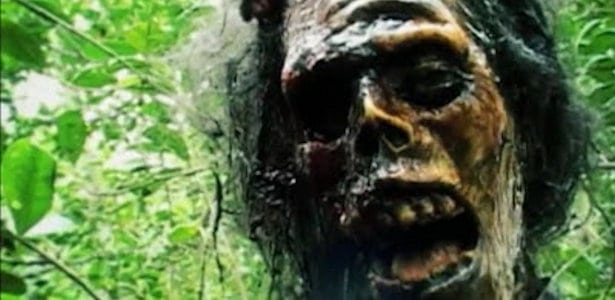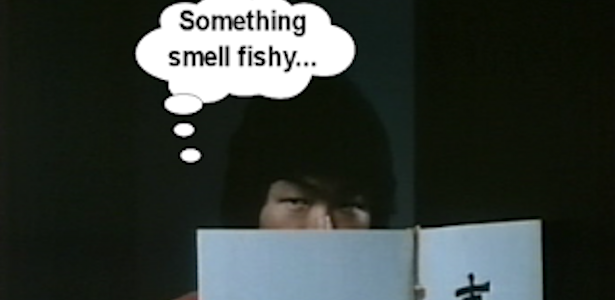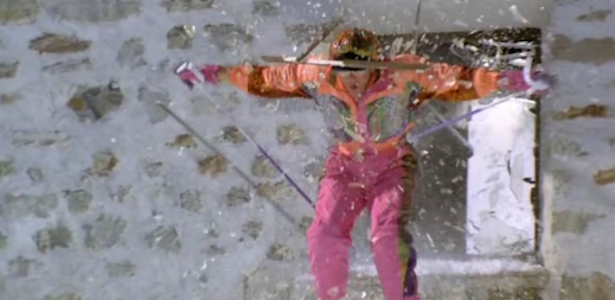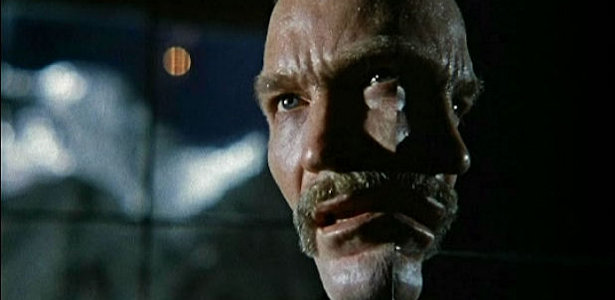Whether you know it or not, if you have watched low-rent movies in the '80s, you have probably seen at least a handful of South African movies. For a while they were cranking out INDIANA JONES AND THE TEMPLE OF DOOM (1984) and ROMANCING THE STONE (1984) inspired adventures that challenged the patience of even the most die-hard video junkies. JEWEL OF THE GODS (1988) is a perfect example, though it sports a bigger budget than most. Martial arts fans will no doubt think of James Ryan's KILL OR BE KILLED (1976) and KILL AND KILL AGAIN (1981) which made a huge impression on me as a pre-teen.
In spite of the few fun outings I've stumbled across, I've never come away feeling like there is a great wealth of unexplored cinema coming out of what was at one time the most contentious place on earth. That is about to change. Well... maybe a bit. Oh, and I should mention: Even though I will make this as spoiler-free as possible, if you plan on watching the film, don't read this or any other review. You can thank me later.
 Opening with a torrential rainstorm beating down on a funeral party, a blind man, Aadrian van der Byl (Cobus Rossouw) has shut himself up inside his castle, drinking heavily. Bitter about his father's death, he is soon beset upon by his brother Paul who has been missing for 20 years after blinding Aadrian during an argument as kids. Aadrian still furious at his brother who has only showed up to cash in on the large inheritance, in a fit of drunken rage kills him and hides his body in a wooden bench chest in the parlor room. Just when he had gotten his manservant, Freddie (Pieter Fourie), to help him dispose of the body, his wife shows up. Then his aunt Emily (Elsa Fouché), who he has never heard from in 10 years shows up sniffing around for money along with her creepy mentally challenged son Errol (Dawie Malan). As if that weren't enough, a detective, Sergeant Grobbelaar (Louw Verwey), shows up while investigating the whereabouts of Paul. The will cannot be read until Paul is present.
Opening with a torrential rainstorm beating down on a funeral party, a blind man, Aadrian van der Byl (Cobus Rossouw) has shut himself up inside his castle, drinking heavily. Bitter about his father's death, he is soon beset upon by his brother Paul who has been missing for 20 years after blinding Aadrian during an argument as kids. Aadrian still furious at his brother who has only showed up to cash in on the large inheritance, in a fit of drunken rage kills him and hides his body in a wooden bench chest in the parlor room. Just when he had gotten his manservant, Freddie (Pieter Fourie), to help him dispose of the body, his wife shows up. Then his aunt Emily (Elsa Fouché), who he has never heard from in 10 years shows up sniffing around for money along with her creepy mentally challenged son Errol (Dawie Malan). As if that weren't enough, a detective, Sergeant Grobbelaar (Louw Verwey), shows up while investigating the whereabouts of Paul. The will cannot be read until Paul is present.
 While I've seen this referred to as a giallo, it really isn't. It's much more in the vein of the subgenre inspired by James Whale's classic OLD DARK HOUSE (1932). Feeling much like a jigsaw puzzle with pieces of Agatha Christie and Alfred Hitchcock, veteran South African director Dirk de Villers, mounts one of the most atmospheric modern gothic thrillers in recent memory. Using oblique angles, rack focus shots and unusual editing, the look of the movie is every bit the match for the twisty script and nicely tuned performances.
While I've seen this referred to as a giallo, it really isn't. It's much more in the vein of the subgenre inspired by James Whale's classic OLD DARK HOUSE (1932). Feeling much like a jigsaw puzzle with pieces of Agatha Christie and Alfred Hitchcock, veteran South African director Dirk de Villers, mounts one of the most atmospheric modern gothic thrillers in recent memory. Using oblique angles, rack focus shots and unusual editing, the look of the movie is every bit the match for the twisty script and nicely tuned performances.
There are also some interesting visual nods to Corman's Edgar Allan Poe adaptations. I may be reading this in, but the protagonist having wrap-around dark glasses seems like a subtle nod to Vincent Price's distinctive look in THE TOMB OF LIGEIA (1964). Also the castle shots are reminiscent of the foreboding castle shots used in nearly every one of Corman's Poe films. To be fair, those shots, along with may others, were probably inspired by James Whale's shots in FRANKENSTEIN (1931) and BRIDE OF FRANKENSTEIN (1935).
Either way, this sort of reference was the last thing I expected out of a South African film that, to my knowledge, never got distribution outside of its native country. It is possible that the lack of bloodletting, nudity or monsters failed to impress distributors who were looking for sensational fodder for drive-ins and second-run cinemas, but I think if it had, it would be considered an under-appreciated classic, instead of an unknown classic. In many ways it bears resemblance to the low-budget Spanish thrillers with lots of moody moments and the running theme of mental imbalance.
While this may not be the easiest movie to get a hold of it is well worth the effort. If I owned a DVD company, I would put this out in a remastered special edition before I promptly go bankrupt.
In spite of the few fun outings I've stumbled across, I've never come away feeling like there is a great wealth of unexplored cinema coming out of what was at one time the most contentious place on earth. That is about to change. Well... maybe a bit. Oh, and I should mention: Even though I will make this as spoiler-free as possible, if you plan on watching the film, don't read this or any other review. You can thank me later.
 Opening with a torrential rainstorm beating down on a funeral party, a blind man, Aadrian van der Byl (Cobus Rossouw) has shut himself up inside his castle, drinking heavily. Bitter about his father's death, he is soon beset upon by his brother Paul who has been missing for 20 years after blinding Aadrian during an argument as kids. Aadrian still furious at his brother who has only showed up to cash in on the large inheritance, in a fit of drunken rage kills him and hides his body in a wooden bench chest in the parlor room. Just when he had gotten his manservant, Freddie (Pieter Fourie), to help him dispose of the body, his wife shows up. Then his aunt Emily (Elsa Fouché), who he has never heard from in 10 years shows up sniffing around for money along with her creepy mentally challenged son Errol (Dawie Malan). As if that weren't enough, a detective, Sergeant Grobbelaar (Louw Verwey), shows up while investigating the whereabouts of Paul. The will cannot be read until Paul is present.
Opening with a torrential rainstorm beating down on a funeral party, a blind man, Aadrian van der Byl (Cobus Rossouw) has shut himself up inside his castle, drinking heavily. Bitter about his father's death, he is soon beset upon by his brother Paul who has been missing for 20 years after blinding Aadrian during an argument as kids. Aadrian still furious at his brother who has only showed up to cash in on the large inheritance, in a fit of drunken rage kills him and hides his body in a wooden bench chest in the parlor room. Just when he had gotten his manservant, Freddie (Pieter Fourie), to help him dispose of the body, his wife shows up. Then his aunt Emily (Elsa Fouché), who he has never heard from in 10 years shows up sniffing around for money along with her creepy mentally challenged son Errol (Dawie Malan). As if that weren't enough, a detective, Sergeant Grobbelaar (Louw Verwey), shows up while investigating the whereabouts of Paul. The will cannot be read until Paul is present. While I've seen this referred to as a giallo, it really isn't. It's much more in the vein of the subgenre inspired by James Whale's classic OLD DARK HOUSE (1932). Feeling much like a jigsaw puzzle with pieces of Agatha Christie and Alfred Hitchcock, veteran South African director Dirk de Villers, mounts one of the most atmospheric modern gothic thrillers in recent memory. Using oblique angles, rack focus shots and unusual editing, the look of the movie is every bit the match for the twisty script and nicely tuned performances.
While I've seen this referred to as a giallo, it really isn't. It's much more in the vein of the subgenre inspired by James Whale's classic OLD DARK HOUSE (1932). Feeling much like a jigsaw puzzle with pieces of Agatha Christie and Alfred Hitchcock, veteran South African director Dirk de Villers, mounts one of the most atmospheric modern gothic thrillers in recent memory. Using oblique angles, rack focus shots and unusual editing, the look of the movie is every bit the match for the twisty script and nicely tuned performances.There are also some interesting visual nods to Corman's Edgar Allan Poe adaptations. I may be reading this in, but the protagonist having wrap-around dark glasses seems like a subtle nod to Vincent Price's distinctive look in THE TOMB OF LIGEIA (1964). Also the castle shots are reminiscent of the foreboding castle shots used in nearly every one of Corman's Poe films. To be fair, those shots, along with may others, were probably inspired by James Whale's shots in FRANKENSTEIN (1931) and BRIDE OF FRANKENSTEIN (1935).
Either way, this sort of reference was the last thing I expected out of a South African film that, to my knowledge, never got distribution outside of its native country. It is possible that the lack of bloodletting, nudity or monsters failed to impress distributors who were looking for sensational fodder for drive-ins and second-run cinemas, but I think if it had, it would be considered an under-appreciated classic, instead of an unknown classic. In many ways it bears resemblance to the low-budget Spanish thrillers with lots of moody moments and the running theme of mental imbalance.





































































